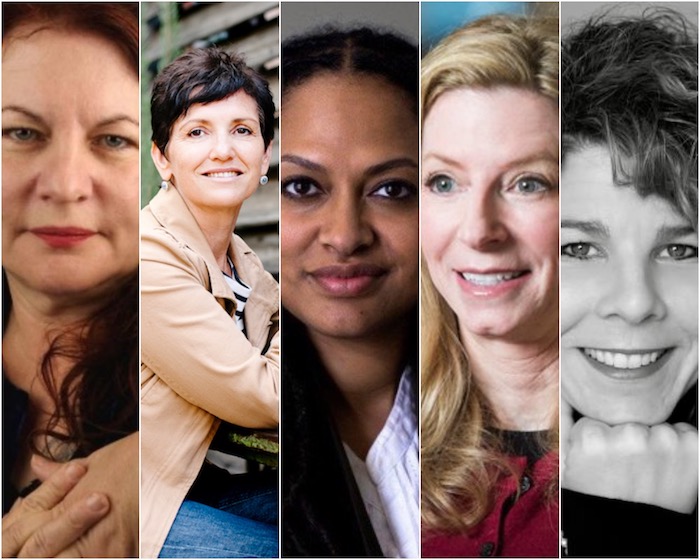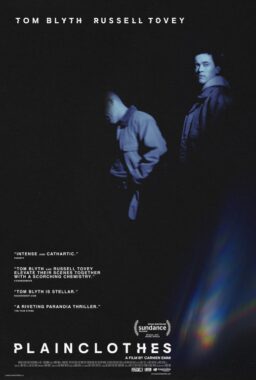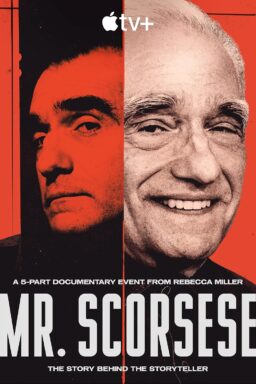By now, we all know that it takes a village to raise a child. Less well-known is that it takes an army of women to raise consciousness about how Hollywood’s gender and race imbalance—both in front of the camera and behind it—is inimical to equal employment, pay, and representation.
Largely due to the efforts of activist female filmmakers including Allison Anders, Ava DuVernay and Maria Giese, agenda-driven academics such as Martha Lauzen and Stacy Smith (all five pictured above), and institutions such as The Bunche Center at UCLA, inclusion has been a critical and still unresolved factor for the past two decades in the Hollywood movie equation.
Sadly, as these women warriors, guerrilla girls and inclusion revolutionaries challenge and shake up the Hollywood establishment, exclusion remains the norm. Because of Lauzen’s tenacity, we know that for the past 20 years the percentage of female directors has wavered between 5 and 11 percent. Because of Smith’s diligence, we know the ratio of males to females on screen is stuck between 3:1 and 2.5:1 (In 1991, Rodney Mitchell, then the diversity officer at the Screen Actors Guild, told me that by his Guild’s numbers, the onscreen male:female ratio was roughly 2.35:1. 26 years later, Smith’s 2007 study of the percentage of women who have speaking roles on screen likewise shows a 2.35:1 ratio.)
I have written about this issue since 1984. To borrow a line from Manohla Dargis, I feel like a broken record broken record broken record. Why does the needle seem to be stuck?
Because it’s easier to point to womens’ successes in the industry as positive signs of change—Kathryn Bigelow wins a best director Oscar for “The Hurt Locker” (2008)! Patty Jenkins directs the superheroine movie, “Wonder Woman” (2017)! Ava DuVernay makes a girl-centered fantasy, “A Wrinkle in Time” (2018)!—than to make permanent structural change in the industry. Just because good things are being made and honored by women in Hollywood doesn’t mean the problem of systemic gender bias in the industry has been solved.
And because beleaguered Hollywood, fighting the rise of streaming services that eat at its theatrical profits and the horrific charges of sexual predation that eat at its soul, historically uses these other issues to push inclusion back on the back burner. This, even though predation is a symptom of the power and gender imbalance the activists have sought to rectify. (While I want to celebrate the stories of the change agents who blazed the trail for #TimesUp, the legal fund dedicated to fighting workplace harassment across the board, and while the work of The Bunche Center is hugely important, I will focus here on those women and institutions who have done the most for female representation.)

Since 1998, Martha Lauzen, professor at San Diego State University, and head of the Center for Women in Television and Film, has published the annual Celluloid Ceiling report tracking film employment, the ‘Boxed In’ report, that does the same for women’s employment in TV, and ‘It’s a Man’s World,’ tracking representation of women on the big and small screens.
In the 1990s, she read newspaper articles about how women were doing better in film and TV. The reports were anecdotal—they were about the unicorns, or exceptions—and had no correlation with what she was seeing on the big and small screens, and in the credits.
“I started conducting research on an annual basis to accurately document women’s underemployment, and to build industry awareness,” she wrote in an email. It didn’t occur to her that it would take decades to build momentum and “for the demographics of the country to help push it along.” The Center tracks employment for women in all areas behind the camera, from cinematographer to screenwriter. (Lauzen was the first to provide statistics showing how a woman director boosts the number of women on the set: on films with exclusively male directors, women accounted for only 15% of editors and 5% of cinematographers. On films with female directors, the percentages of women editors rose to 35%, and cinematographers to 26%.)
It seemed clear, she said, “that the data was essential to keep the conversation going.” She coined the term “gender inertia” to describe how the numbers of women on and behind the screen have failed to rise substantially over the past two decades.
Not only has the data she collected kept the conversation going, organizations including the ACLU and the California State Assembly cite the Center’s findings as continuing evidence of chronic and consistent gender bias in Hollywood.

In 1999, Allison Anders, the gifted filmmaker of “Gas Food Lodging” (1992) and “Grace of My Heart” (1996) had it with Hollywood’s double-standard. Why did her male peers have career momentum? Even after a flop, they were offered another movie. Why, if Anders or another woman had a success, was it a “fluke”?
She wanted answers—and solutions. She emailed sister filmmakers and sympathetic journalists. And, in April 2000, the Women Filmmakers’ Summit took place at the late, lamented Miramar Hotel in Santa Barbara, described by film historian Cari Beauchamp in a recent article as “run-down, but still vibrant.”
There were established directors at Miramar, like Martha Coolidge (“Valley Girl,” “Real Genius,” “Rambling Rose”), and also newcomers, like Patricia Cardoso and Gurinder Chadha, who within a few years respectively would make Real Women Have Curves and Bend it Like Beckham. After a “venting” session, the assembled concluded that it wasn’t personal, only business, and that the business was tilted in men’s favor. After their common goal of gender equality, they named themselves “50/50.” In the years since, the women who were there continue to network, gaining strength and strategy from each other.
A handful of Miramar alumna collaborated with the Guerrilla Girls, the feminist collective that stages humorous interventions such as billboards and posters—to highlight gender inequality. As “Kathe Kollwitz,” nom de guerre of a GG co-founder, said in a recent email, “We knew Hollywood was bad, but it wasn’t until looking at statistics like Martha Lauzen’s that we realized it was even worse than the art world!”
For the 2001 Sundance Film Festival, Miramar alumna and the Guerilla Girls targeted companies without movies by female filmmakers up for distribution. The activists identified the companies with stickers that read, “THESE DISTRIBUTORS DON’T KNOW HOW TO PICK UP WOMEN.”
The following year, “those directors helped fund a billboard, “The Anatomically Correct Oscar.”

The billboard had a caricature of the statuette with a caption—”He’s White & Male—just like the guys who win!” and the facts that only 3% of the acting awards had gone to people of color, and Best Director had never gone to a woman. My favorite among the Guerrilla Girls actions was a 2006 billboard on Sunset Boulevard during Oscars month. It showed a Queen Kong, a gorilla in a red gown, mad and manacled, with the datapoints that female filmmakers directed only 7 percent of the films of 2005 and that only three women had ever received best director nominations. A handful of Hollywood execs, male and female, have told me they nearly had car crashes driving past the sign while reading it. The Guerrilla Girls have updated these billboards and exhibited them around the world. In 2016, they updated many of the signs during the #OscarsSoWhite campaign and put them of the streets of Minneapolis.

A year after the Guerrilla Girls’ “anatomically correct” billboard appeared in 2002, Stacy Smith joined the faculty of the Annenberg School for Communication at the University of Southern California.
She is the founding director of The Media, Diversity and Social Change Initiative (MDSC), which in 2017 rebranded itself as The Annenberg Inclusion Initiative.
Smith and her colleagues took an intersectional approach to the analysis of 800 films made between 2007 and 2015. Their findings included: That women are only 30% of those on screen, and when they are their characters are hypersexualized by skimpy clothing and nudity; That the representation of non-white characters consistently is lower onscreen than the percentages of African Americans, Hispanics and Asian Americans in the general population; That when an African American is in the director’s chair the percentage of black characters climbs from 10% to 39%; That when men are in the director’s chair the number of women onscreen is roughly 30% and when women are the percentage of women onscreen rises to 41%. Smith calls the disproportionately low numbers of non-whites and women onscreen an “epidemic of invisibility.”
Smith, like Lauzen, is increasingly concerned with finding solutions to the seemingly intractable problem of onscreen underrepresentation of women, non-whites and gender nonbinaries. In a 2016 TED Talk, Smith suggested three ways to improve the numbers of women and nonwhites on and behind the screen. One of the suggestions was the “inclusion rider” that Frances McDormand talked about in her Oscar acceptance speech. Namely, a stipulation that actors and actresses can ask (or demand) to have inserted into their contracts, which would require a certain level of inclusion among a film’s cast and crew.

Maria Giese was hardly the first female filmmaker to note that the Hollywood playing field was not exactly level. But she may be the first who described that field as “vertical.” After receiving her MFA in film production from UCLA in 1994, and making two indies, “When Saturday Comes” (1996) and “Hunger” (2001, pictured above), she found it increasingly challenging to get another feature made.
The numbers were against her. Between 2000 and 2001 The percentage female directors dropped from 11% in to 6%. Giese was frustrated. She thought of “Norma Rae,” “Erin Brockovich” and “Nine to Five.” She knew that Hollywood relished making movies about women who triumph over the odds. But when it came to helping female filmmakers triumph over the odds in Hollywood’s own clubby universe, the industry was less interested.
By 2011, she was broke and angry. She studied the data gathered by Lauzen and Smith and collected her own. She studied case law and brought her files to the Equal Opportunity Employment Commission in 2013. The EEOC needed more data. Giese took her files to the ACLU which conducted an independent investigation. In May 2015, the ACLU wrote an extraordinary 15-page letter to the EEOC that concluded, “the statistics and anecdotal evidence we have gathered points to systemic discrimination.”
The EEOC does not comment on investigations. Before it sues employers for noncompliance, it mediates employment discrimination. According to Deadline Hollywood’s David Robb in February 2017, the EEOC was working on mediation. From leaks to which I have been privy, I understand that mediation efforts are in progress.

The rest of us work towards inclusion. Ava DuVernay just does it. In 2010, the year she completed “I Will Follow,” her first feature film, she also founded AFFRM (now ARRAY), a collaborative that brings black-themed and female-themed art films to cities across the country. Thus far, 15 independent films—including “I Will Follow” and DuVernay’s “Middle of Nowhere”—have found audiences. The result: 15 films with mostly non-white and female stories, actors and crews got distribution via DuVernay’s insistence on inclusion.
In 2016, when she was named creator, writer and producer of the episodic cable series “Queen Sugar,” DuVernay announced that the director of each episode would be a woman. When reporters questioned this, she responded, “If ‘Game of Thrones’ can have three seasons of all male directors, why can’t we have three of all female directors?” The result: Women who needed more credits to get into the Directors Guild and to get more work, earned both via DuVernay’s insistence on inclusion.
In 2017, when named director of “A Wrinkle in Time,” DuVernay cast the Murry family as multiracial: White dad, black mom, one biracial child and the other of Asian heritage. The result: A family that looks more like America than the ones we see in most movies and television.
In 1980, the year I began reviewing films for the Village Voice, the percentage of women directing films was .05%. You read that right: ½ of 1%. Twenty years later, in 2000, it was 11%. I admit, I was optimistic. But in 2017, the number is still 11 %. This, despite the agents of social change I celebrate here. Who would have thought that in Hollywood change is geological?
These women and institutions are doing great work not only in keeping the conversation going, but in keeping Hollywood’s feet to the fire. Still, I wonder, could we do better?
And I think, each of the inclusion warriors is doing better than her best. They’ve given Hollywood the longitudinal data and a snapshot of each year for the past 20 years. They’ve crunched the data so Hollywood knows to the dollar that movies with women and by women make money. They have schooled Hollywood so it knows that when it holds up a mirror to America, it reflects back as too male and too pale.
And I think, Hollywood, we’ve done our job. Now do yours.











